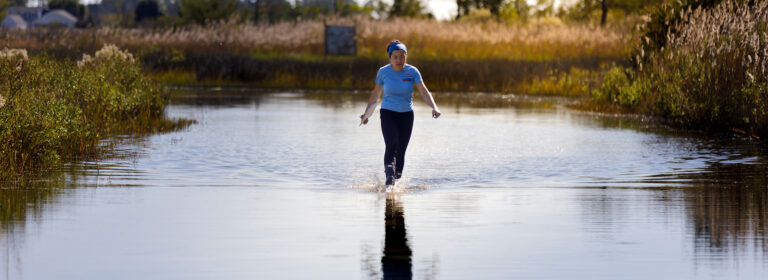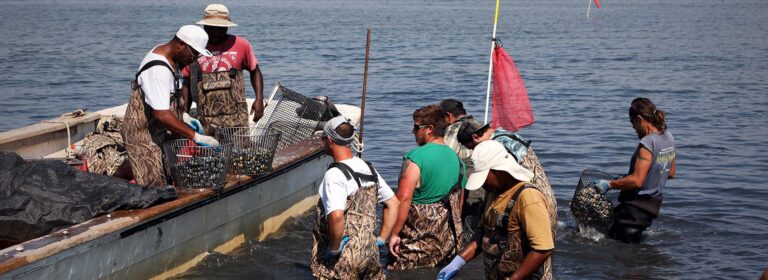What Happens After the Catch?
Tracking Striped Bass in the Chesapeake Bay
As striped bass (Morone saxatilis—known in the Chesapeake Bay region as “rockfish”) populations fluctuate, updated data on catch-and-release mortality are vital for guiding the future of recreational fishing in Virginia. This data is being collected by Virginia Sea Grant Graduate Fellow Rachel Kelmartin, whose work will help inform future policy and management decision in the Chesapeake Bay.
“Having the most updated models to create policy allows fishermen—recreational and commercial alike, to utilize a public resource and prevent it from being overfished,” said Kelmartin.
Kelmartin is a master’s student at George Mason University, pursuing a degree in Environmental Science and Policy with a concentration in Aquatic Ecology. Her research focuses on understanding what happens to striped bass after being caught and released by recreational anglers, filling a decades-long gap since the last data collection in the 1990’s.
Catch and release does not always guarantee a second chance at life. Striped bass can experience significant stress while being caught and handled by recreational anglers. While fish may appear to be fine when released, 9% succumb to these stress factors over time and do not survive the experience of being caught.

Reel 'em in, release 'em right!
Handle your catch like a pro with these tips to reduce catch and release mortality.
Limit the fish’s time out of water
Handle fish and all gear with wet hands
Support the fish horizontally using both hands
Release the fish at the location of retrieval
Avoid fishing during the peak of summer to avoid heat stress on the fish
- If you hook a fish’s gut, cut the line as close as possible to the hook and leave the hook in. Over time, the fish will eject the gut hook
Because the Chesapeake Bay serves as the most significant nursery habitat for striped bass on the East Coast, this information is critical to understanding how recreational fishing affects their populations.
To gather this data, Kelmartin selected the Patuxent River in Maryland as her research site– a tributary that represents the broader Chesapeake Bay spawning stock. With its mix of fresh and saltwater and its narrow width, the Patuxent offers an ideal environment for monitoring fish movement.
Using acoustic telemetry tags, Kelmartin tracks the movements of striped bass after release. When a fish is caught, it is tagged with a small transmitter that sends an acoustic signal to nearby receivers. This allows researchers to determine whether the fish survives, leaves the Patuxent River, or faces mortality after release.
Tag, you're it!
- Acoustic Telemetry Tag: This device transmits an acoustic “ping” unique to each tag, which sends data to nearby receivers. These tags can contain various sensors to include specific information, such as pressure sensors for depth or temperature sensors. In Kelmartin’s research, the tag identified the individual fish and transmitted an acoustic signal to the receiver every 30 seconds. The tag was attached externally to a Floy Tag with a dissolvable suture designed to release naturally after about 70 days in warm water.
- Floy Tag: This externally attached tag displays a unique identification number for each fish and includes a website where anglers can report their catch and note whether the fish was kept or released.

Photo courtesy of Rachel Kelmartin
One of Kelmartin’s favorite aspects of her research is working with the recreational fishermen community. Anglers play an important role in her research– if they catch a fish with a Floy tag, they can report it through Tag Chesapeake, an initiative led by Coastal Conservation Association (CCA) Maryland, to help provide valuable data on fish movement and survival.
“I believe most research should start with asking the community what problems they want to see addressed and listening to their past experiences to help formulate research questions and methodology,” said Kelmartin.
Upon receiving her master’s degree, Kelmartin plans to stay in Virginia working for the Virginia Department of Wildlife Resources to continue working on applied research and serving her community.
“Personally, experiencing the joy from the local fishing community when we were interested in a problem relevant to their personal well-being and livelihoods reinforced my love for applied research and working with the community directly,” said Kelmartin.
Photos by Lathan Goumas | Virginia Sea Grant
Story by Bayleigh Albert | Virginia Sea Grant
Published November 5, 2025.
“Personally, experiencing the joy from the local fishing community when we were interested in a problem relevant to their personal well-being and livelihoods reinforced my love for applied research and working with the community directly,” Kelmartin said.





